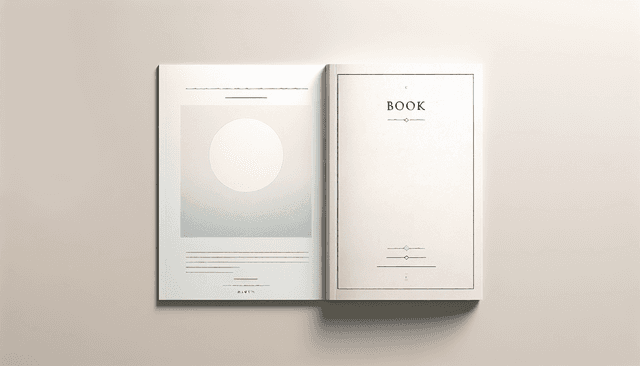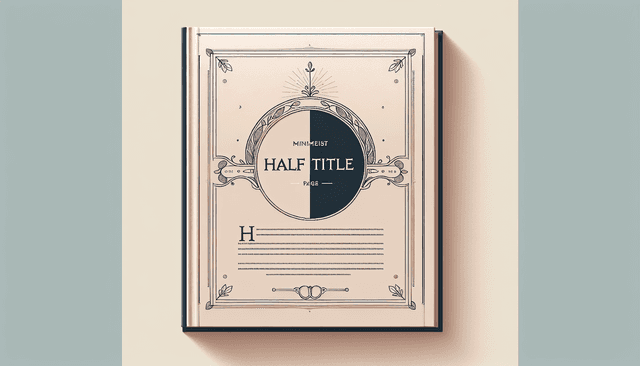Table of Contents
Navigating the world of book formatting can feel a bit overwhelming, right? You might have stumbled across terms like “half title page” and thought, “What on earth is that?” You’re not alone! Many people get confused by the distinguishing features of book layouts, and it’s completely normal to seek clarity.
If you stick around, I promise you’ll get the lowdown on what a half title page is, why it’s important, and how it differs from the more familiar title page. By the end, you’ll have the insights you need to confidently tackle your own book layout choices.
We’ll explore the purpose, elements, and common pitfalls of half title pages, along with some handy examples to guide you. So, let’s unravel this mystery together!
Key Takeaways
- A half title page is a single page showing just the book’s title, typically found before the full title page.
- Its purpose is to create anticipation and set the tone for the book, acting as a clean introduction to the title.
- This page should focus on simplicity, featuring only the title with space around it for emphasis.
- Unlike the title page, which includes the author and publisher, the half title page is optional and more minimalist.
- Common mistakes include overcrowding the design, inconsistent fonts, and typos, which can detract from its professional appeal.
- Consider using it in traditional publishing, especially if you have longer front matter or multiple sections in your book.

What is a Half Title Page?
A half title page is a unique element in a book’s front matter, typically containing just the title of the book, usually printed on the right-hand page.
This page serves as a clever way to introduce the title without additional information like the author’s name or the publisher’s details.
Imagine flipping through the pages of your favorite novel and encountering a simple yet striking page that only displays its title; that’s the magic of the half title page.
It’s not just about aesthetics—it’s about creating a sense of anticipation and focus for the reader as they prepare to dive into the content.
Purpose of a Half Title Page
The primary purpose of a half title page is to set the tone for the book right from the start.
It acts as a pause before the full title page, allowing readers to absorb the book’s title before encountering other vital details.
By creating separation from the front matter, it also emphasizes the title, making it more memorable to readers.
Most importantly, it adds a professional touch, demonstrating the author’s attention to detail in book presentation.
Readers get a glimpse of the book’s identity and essence without distraction, fostering curiosity about what awaits on the following pages.
Elements of a Half Title Page
A half title page typically consists of just the book title, centered on the page.
Some may choose to include the subtitle if applicable, but that’s entirely up to the author’s discretion.
It’s crucial to leave ample space around the title to underscore its importance and provide a clean look.
Design matters here; think about the font style, size, and color—these elements should align with the overall theme of the book.
For example, a romantic novel may benefit from an elegant script, while a thriller might call for bold, block letters.
Differences Between Half Title Page and Title Page
The half title page and the title page serve distinct purposes, despite both being located early in a book.
The half title page, as mentioned, usually only features the title, while the title page includes the title, subtitle, author’s name, and sometimes publisher details.
Think of the half title page as a teaser, enticing readers, and the title page as the formal introduction of the book.
While the half title page is an optional design choice, the title page is a standard component of book formatting.
In summary, the half title page creates a minimalist entry point, while the title page gives a comprehensive overview of the book’s credentials.

Common Mistakes to Avoid
When designing a half title page, it’s easy to overlook a few key details that can impact its effectiveness.
One common mistake is crowding the page with too much information or unnecessary design elements.
The beauty of a half title page lies in its simplicity; so sticking to just the title is usually the best approach.
Another pitfall is inconsistent font choice; ensure the fonts match the overall style of the book.
Avoid using a font size that is too small, which can make the title hard to read, especially if the book is printed.
Additionally, failing to properly center the title can lead to an unbalanced look, detracting from the professional feel.
Finally, don’t forget to proofread; a typo on the half title page can be the first impression readers have of your work, and you want it to be a good one.
Examples of Half Title Pages
Seeing examples of half title pages can ignite your creativity and provide some much-needed inspiration.
For classic literature, consider the half title pages found in editions of Pride and Prejudice by Jane Austen, where the title stands elegantly alone.
Modern books like Where the Crawdads Sing by Delia Owens also feature distinctive half title pages that engage readers visually.
A design tip is to research how different genres approach their half title pages; a romantic novel may go for softer lettering, while a crime thriller might prefer sharper, more impactful designs.
Many authors incorporate subtle illustrations or background textures to further enhance the half title design without overpowering the title itself.
Visiting publishing websites or platforms like automateed.com can also provide examples and templates that spark ideas.
When to Use a Half Title Page
Knowing when to include a half title page can enhance your book’s presentation and clarity.
It’s typically used in traditional publishing, especially in novels and academic works, as a means to structure the front matter.
If your book features a rich front matter with a preface or acknowledgments, a half title page serves as a subtle transition into the body of the work.
Some authors opt to use it for promotional pieces or portfolios to build a professional impact.
If your writing includes multiple sections or volumes, a half title page can delineate between them, giving readers a moment to reset before diving back in.
And remember, while it’s a common practice, it’s not mandatory; trust your instincts and choose what feels right for your book’s character.

Conclusion on Half Title Pages
In wrapping up our exploration of half title pages, it’s clear they add a unique charm to books, setting the stage for what’s to come.
They serve not just as an aesthetic choice but as a way to engage readers right from the beginning.
Remember, a well-designed half title page shows attention to detail, hinting at the quality of the writing that follows.
As you craft your own book, consider how a half title page can contribute to the overall experience for your readers.
It’s those little touches that can make your work memorable and professional.
So, when in doubt, embrace the simplicity of a half title page, and let your title shine.
FAQs
A Half Title Page is a page in a book that typically contains only the title of the work and the author’s name. It precedes the title page and serves as a visual introduction without additional details.
The purpose of a Half Title Page is to provide a streamlined introduction to the book. It adds elegance to the book’s layout and prepares readers for the subsequent title page with more detailed information.
You should use a Half Title Page in formal publications, such as novels or academic texts, where a professional presentation is desired. It is particularly beneficial for enhancing the visual appeal and structure of physical books.
Common mistakes include omitting the Half Title Page altogether or overcrowding it with too much information. Ensure it remains simple, showcasing just the title and author’s name for clarity and aesthetic appeal.



